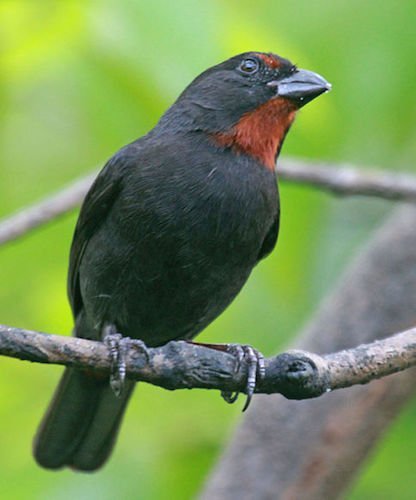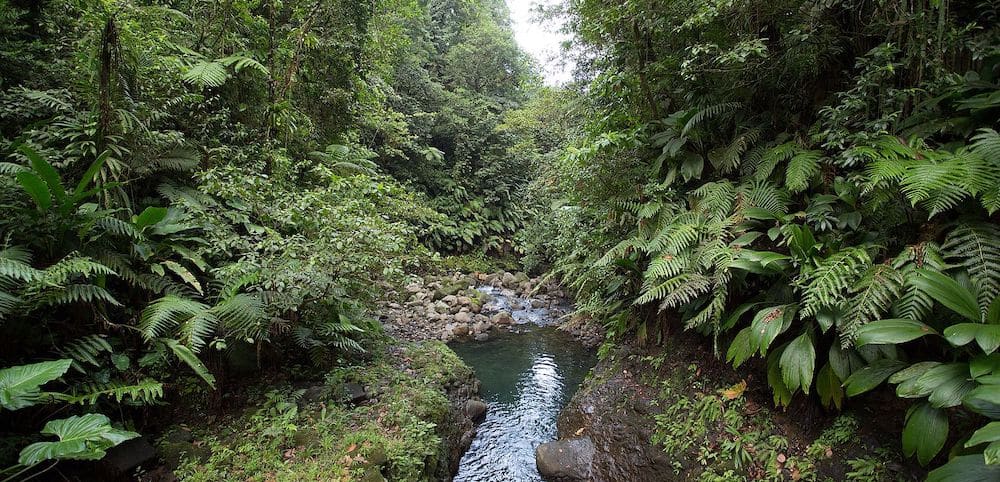Guadeloupe

Guadeloupe is an overseas department of France in the Caribbean’s Leeward Islands. It consists of six inhabited islands – Basse-Terre, Grande-Terre, Marie-Galante, La Désirade, and two Îles des Saintes – as well as six uninhabited islands numerous islets and rocks. It is south of Antigua & Barbuda and Montserrat and north of Dominica. The capital city is Basse-Terre, on the southern west coast of Basse-Terre Island; the most populous city is Les Abymes and the main centre of business is neighbouring Pointe-à-Pitre, both on Grande-Terre Island. It had a population of c. 395,000 in 2024. The land area of the archipelago is a little over 1,600 square kilometres (c.600 square miles). It used to include Saint Barthélemy and Saint Martin until (2007) they become independent of Guadeloupe following a referendum.
As with the other overseas departments, Guadeloupe is also one of the twenty-six regions of France (being an overseas region) and an integral part of the Republic. As part of France, Guadeloupe is part of the European Union; hence, as for most EU countries, its currency is the euro.

La Grande Soufrière – ©Anthony SIMONET, CC BY-SA 3.0 via Wikimedia Commons
Guadeloupe was formed from multiple volcanoes, of which only La Grande Soufrière is not extinct, last erupting nearly fifty years ago. Basse-Terre Island is separated from Grande-Terre by a narrow sea channel called Salt River. Basse-Terre has a rough volcanic relief while Grande-Terre features rolling hills and flat plains. They are grouped with Marie-Galante, the third-largest island, followed by La Désirade, a north-east slanted limestone plateau, the highest point of which is 275 metres (902 ft). To the south lies an archipelago called Les Saintes made up of eight islands, only two of which are inhabited – the Îles de Petite-Terre, which are two islands (Terre de Haut and Terre de Bas) totalling just 2 km2.
The islands are part of the Leeward Islands, so called because they are downwind of the prevailing trade winds, which blow out of the northeast. This was significant in the days of sailing ships. Grande-Terre is so named because it is on the eastern, or windward side, exposed to the Atlantic winds. Basse-Terre is so named because it is on the leeward south-west side and sheltered from the winds. Guadeloupe has a tropical climate tempered by maritime influences and the Trade Winds. There are two seasons, the dry season called “Lent” from January to June, and the wet season called “winter”, from July to December.
Birding Guadeloupe
With fertile volcanic soils, heavy rainfall and a warm climate, vegetation on Basse-Terre is lush. Most of the island’s forests are on Basse-Terre, containing such species as mahogany, ironwood and chestnut trees.[4] Mangrove swamps line the Salée River. Much of the forest on Grande-Terre has been cleared, with only a few small patches remaining. The dry forest occupies a large part of the islands of Grande-Terre, Marie-Galante, Les Saintes, La Désirade and also develops on the leeward coast of Basse-Terre. The coastal forest is more difficult to develop because of the nature of the soil (sandy, rocky), salinity, sunshine and wind.
The Mangrove forest that borders some of Guadalupe’s coasts is structured in three levels, from the closest to the sea to the farthest. On the first level are the red mangroves; on the second, about 10 metres (33 ft) from the sea, the black mangroves form the shrubby mangrove; on the third level the white mangroves form the tall mangrove. Behind the mangrove, where the tide and salt do not penetrate, a swamp forest sometimes develops, unique in Guadeloupe. The representative species of this environment is the Mangrove-medaille. The waters of the islands support a rich variety of marine life.
Few terrestrial mammals, aside from bats and raccoons, are native to the islands. The introduced Javan mongoose is also present on Guadeloupe. Bird species include the Lesser Antilles endemics such as the Purple-throated Carib and Guadaloupe’s only endemic, the Guadeloupe woodpecker. Around 290 species have been recorded, although only around 80 species nest on the islands.

Guadalupe National Park – ©Manfred Foeger CC BY-SA 4.0 via Wikimedia Commons
The Guadalupe National Park was created on 35 years ago and the Biosphere Reserve of the Guadeloupe Archipelago (Réserve de biosphère de l’archipel de la Guadeloupe) was created three years later, and the marine site of Grand Cul-de-sac was listed as a wetland of international importance.
-
Wikipedia
GNU Free Documentation License
http://en.wikipedia.org/wiki/Guadeloupe
-
Number of bird species: 300
(As at June 2024)
Number of endemics: 1
Guadeloupe Woodpecker Melanerpes herminieri
-
Avibase
PDF ChecklistThis checklist includes all bird species found in Guadeloupe , based on the best information available at this time. It is based on a wide variety of sources that I collated over many years. I am pleased to offer these checklists as a service to birdwatchers. If you find any error, please do not hesitate to report them. -
Wikipedia
Annotated ListThis is a list of the bird species recorded in Guadeloupe. Guadeloupe is an overseas department of France located in the Leeward Islands, part of the Lesser Antilles in the Caribbean. The avifauna of Guadeloupe included a total of 294 species according to Bird Checklists of the World as of May 2023. Of them, one is endemic, 11 have been introduced by humans, and 158 are rare or accidental. -
eBird
PDF Checklist303 species (+56 other taxa) - Year-round, All years
-
The Birds of the West Indies
| By Guy M Kirwan, Anthony Levesque, Mark W Oberle & Christopher J Sharpe | Lynx Edicions | 2019 | 400 pages, 1600+ colour illustrations, 650+ colour distribution maps | ISBN: 9788416728176 Buy this book from NHBS.com -
The Guadeloupe Woodpecker
| By Pascal Villard | Societé d'Etudes Ornithologiques de France | 1999 | Paperback | 135 pages, Colour photos, illustrations | ISBN: 9782950654861 Buy this book from NHBS.com
-
Acopian Center for Ornithology
WebpageThe Acopian Center for Ornithology was established in 2006 with the generous support of local philanthropist Sarkis Acopian.
-
https://www.birdscaribbean.org/tag/guadeloupe/
Website
-
MR Réserve Cousteau
InformationSatellite ViewRéserve Cousteau is a protected marine area, located mainly in the municipality of Bouillante and partly in that of Pointe-Noire on coast of the island of Basse-Terre in Guadeloupe. -
NNR IBA Petite Terre Islands
InformationSatellite ViewBird Life International has identified the reserve as an Important Bird Area (IBA) bird reserve. In the forest habitat of Basse-Terre, the IBA-identified species reported are: Least tern (Sterna antillarum), Purple-throated carib (Eulampis jugularis), Green-throated carib (Eulampis holosericeus), Antillean crested hummingbird (Orthorhyncus cristatus), Caribbean elaenia (Elaenia martinica), Scaly-breasted thrasher (Margarops fuscus), and Pearly-eyed thrasher (Margarops fuscatu) -
NNR La Désirade
InformationSatellite ViewThe reserve, with an officially designated area of 62 ha (153 acres), is in the eastern part of the island of Desirade which covers an area of 22 square kilometres (8.5 sq mi). It is to the east of Grande-Terre in the Guadeloupe archipelago. -
NP Guadeloupe
InformationSatellite ViewGuadeloupe National Park (French: Parc national de la Guadeloupe) is a national park in Guadeloupe, an overseas department of France located in the Leeward Islands of the eastern Caribbean region. The Grand Cul-de-Sac Marin Nature Reserve (French: Réserve Naturelle du Grand Cul-de-Sac Marin) is a marine protected area adjacent to the park and administered in conjunction with it. Together, these protected areas comprise the Guadeloupe Archipelago (French: l'Archipel de la Guadeloupe) biosphere reserve.
-
Anthony Levesque Byirding Guadeloupe
GuideLevesque Birding Enterprise -
Caribbean Birding Trail
Tour OperatorThrough birds we connect you to the extraordinary places, diverse cultures and people of the Caribbean. -
Paradise Birding
Tour OperatorGuadeloupe Birding Tour -
Rockjumper
Tour OperatorStarting from Barbados, the most easterly of the islands we embark on numerous short hops to Grenada, St. Vincent and the Grenadines, St. Lucia, Martinique, Dominica, Guadeloupe, Montserrat, Barbuda and ultimately Antigua. -
Sunrise Birding
Tour OperatorThe Lesser Antilles are long series of islands extending north to south between the Atlantic Ocean and the Caribbean Sea. For birders, these islands hold some truly superlative species including more than thirty Lesser Antilles endemics and forty-five Caribbean specialties. On this "Every Endemic" birding tour, we target them all and sample the diverse nature and culture of the Lesser Antilles. Using a combination of air and sea, we'll travel to each island in search of the avian specialties to be found on these 10 magical islands: Antigua, Barbados, Barbuda, Dominica, Grenada, Guadeloupe, Martinique, Montserrat, St. Lucia, and St. Vincent. -
WILLIAM SUAREZ BIRDING TOURS
Tour OperatorAn island-by-island birding tour to observe all possible endemic bird species in the Lesser Antilles. -
WINGS
Tour OperatorThese 10 stunningly beautiful Caribbean islands form the eastern border between the placid Caribbean Sea and the mighty Atlantic Ocean. Each tropical island gem is separated by turquoise seas and boasts rich wetlands, vast open grasslands, dynamic coastlines and lush tropical rainforests. These diverse habitats are home to a lengthy list of highly threatened single-island endemics and near endemics along with a host of indigenous regional specialties.
-
2016 [04 April] - Jesse Fagan - Lesser Antilles
Report10 islands, 14 days, 14 flights, 8 hotels, 1 visit to the emergency room, drive on the right, drive on the left,...you get the picture. It requires a lot of action and movement to see these birds! And see them we did. It was another successful island-hopping adventure this year, and the logistics worked out fine on this logistically complicated tour. Even island time seemed faster. Mark recovered in fine fashion. And we also got all the potential endemics. -
2017 [06 June] - Mark Van Beirs - Lesser Antilles & Trinidad
PDF ReportAntigua, Barbuda, Montserrat, Dominica, Guadeloupe, Martinique, Santa Lucia, Saint Vincent, Barbados and Grenada were the ten islands we visited on our recent Lesser Antilles tour. Some are independent countries in their own right, while others are Overseas Territories. -
2019 [04 April] - Jesse Fagan - Lesser Antilles
PDF ReportAnnotated List -
2020 [03 March] - Victor Emanuel
PDF ReportA very early arrival to the Guadeloupe National Park gave us the opportunity to observe the otherwise difficult-to-see Bridled Quail-Dove. Later, many of us nailed the superb shy Forest Thrush in three separate locations. I have to say that seeing this bird is always challenging, and we were fortunate that many of you got to see it. But the jewel of the crown was about to come, and it happened when a pair of Guadeloupe Woodpeckers landed on an open branch, and we observed it for several minutes. L -
2023 [06 June] - David Hollie
PDF ReportIn total, I walked a bit over 3 km before turning around. I had a conservative count of nine Guadeloupe Woodpeckers including a juvenile, so this is a great place to come if this is still a needed bird; I got much better looks here than anywhere else (including breathtaking views of the maroon belly!). I also got a much better appreciation for just how large these birds are! I also saw plenty of Brown Tremblers, Plumbeous Warblers, and a few Forest Thrush far down the trail and a pair of Spectacled Thrush much closer to the parking area. It wasn’t until my walk back when I was ~500 m from the parking area that I saw a Lesser Antillean Pewee. -
2024 [03 March] - Peg Abbott
PDF ReportAnnotated List
-
Hotel La Toubana
AccommodationHilltop bungalows overlooking the Caribbean Sea and leading down to a beach at Sainte Anne…
-
Guadeloupe Woodpecker
InformationThese dark woodpeckers are endemic to the island of Guadeloupe in the Caribbean. They are classified as “near threatened” due to both human and hurricane destruction of suitable habitat...

